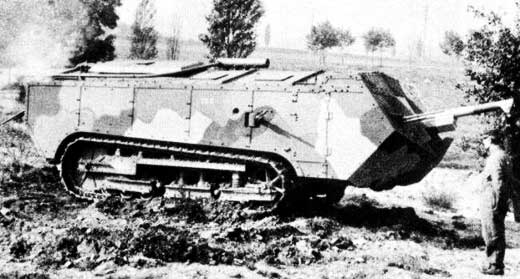

St-Chamond-WWI-Tank - $$7.50
It was almost twice as heavy as the Schneider, had a crew of nine, five of whom served the cannon and machine guns. Four hundred tanks of this model were built. Some were sent to the Western Front in May 1917, others were shipped to Russia. Part of the Fiddlersgreen WWI Tank Collection
St-Chamond-WWI-Tank

Another WWI French Heavy Tank was the St-Chamond (aka: The FCM Char 2C) It was almost twice as heavy as the Schneider, had a crew of nine, five of whom served the cannon and machine guns. Four hundred tanks of this model were built. Some were sent to the Western Front in May 1917, others were shipped to Russia. While superior in some ways to Schneider e.g. armament disposition and longer tracks, it was top-heavy, unstable and had poor cross-country performance with tendency for nose or tail to catch on parapets or banks. The Germans increased width of their trenches and anti-tank ditches to strand a Schneider or St Chamond attempting to cross. There is no doubt that the early tanks presented an enormous psychological factor, especially when they were over running troops in dug-in positions. The larger tanks of WW I, despite their tactical drawbacks, were impressive from the size, weight, and noise aspects. More importantly, they set the stage for rapid development of what would soon become one of the most important weapons in the world's arsenal. |
Keyword (sic): St-Charmond
|
 St-Chamond WWI tank, cannon and soldiers waiting for a bus.  Two alternative types of transmission were planned, mechanical, and electric. The pilot model was not ready until December 1917. On trials the tank performed well, but turning was difficult. Because of this, development was not continued and interest switched to the Char 2C. The Char A and 1B were prototype tanks that were followed by the Char 1A then finally, by the Char 2C |
 Disguised crew members (?) cleverly using their 'splatter masks' to rob the cameraman of his camera.. Their St Chamond tank is named 'Dream Waltz' |
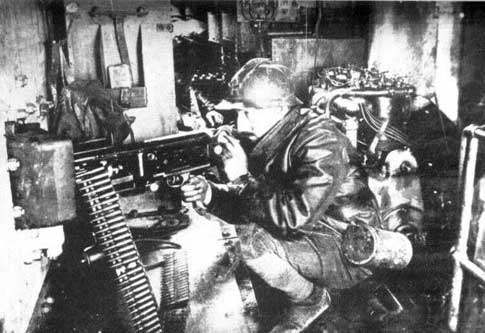 Gunner positions in the St-Chamond WWI tank. You can see just how poorly the side machine gun positions were thought out. The gunner has to crouch down in an awkward position. His shin is inches from a sharp corner of the arch over the tracks. The heat and noise from the engine, located a foot or two away, must have been unbearable. |
 Another St-Chamond tank leaving the St-Chamond tank factory |
 Here's the same St-Chamond tank shop-Note the doors.. There were probably in and out doors |
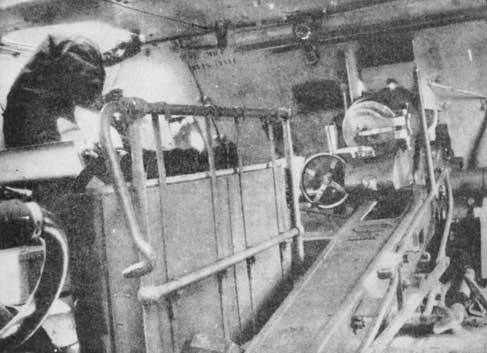 Looking at the interior and the St-Chamond WWI tank cannon. In addition to the handling faults, the Saint-Chamond was found to have further defects when in action for the first time on 5 May 1917. Facilities for crew exit in emergency were poor, vision arrangements were inadequate and the recoil cylinder of the 75-mm. gun was found to be vulnerable to enemy fire. |
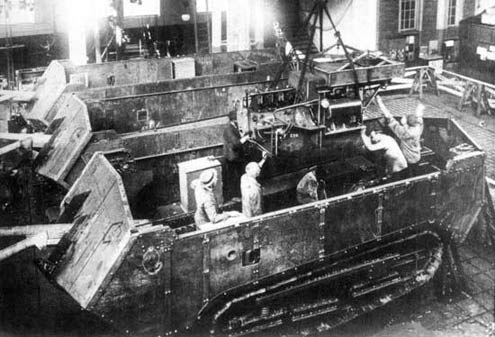 St Chamond tanks being built in the factory. It was recommended that additional 8.5 mm plates should be added to the side plates (which were a basic 8.5 mm.) to give full protection against the German "K" bullet, although this modification was not carried out in full. |
 St-Chamond WWI Tank on the move looking for trouble. It is interesting to note that the original designs included a third single wide track at the front, which should have considerably improved the climbing ability of the machine, although it would also have added to its nose-heaviness. Probably for the latter reason and also, to simplify production, this feature was not included in the tanks built. |
|
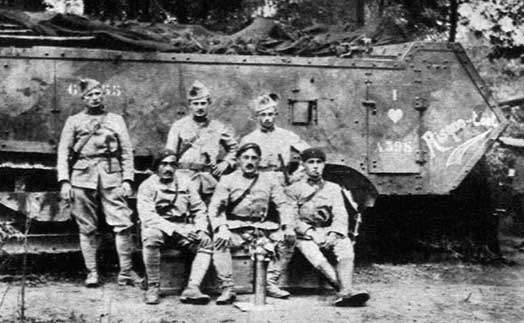 Look at the camo netting across the top of this St-Chamond tank. And judging by his body language, the chap on the left hasn't been getting along very well with his pals. |
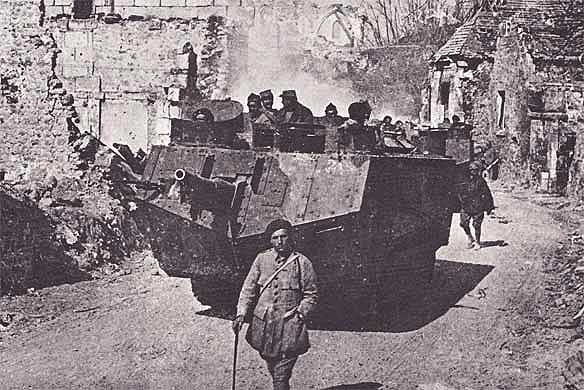 St-Chamond WWI Tank group proudly walking through a wonderfully devastated Idyllic French Village |
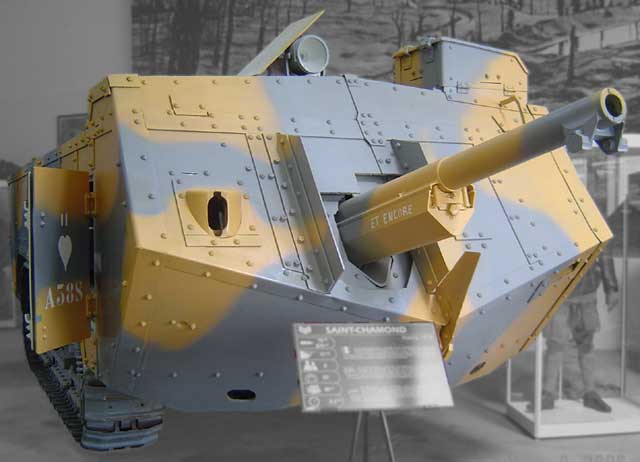 St-Chamond WWI Tank on exhibit. |
|
 A St-Chamond WWI Tank image taken from a plastic model kit. The early prototype had a flat roof and armor down over the tracks, but this limited access for maintenance and became clogged with mud, so the side armor was cutaway to expose the tracks. |
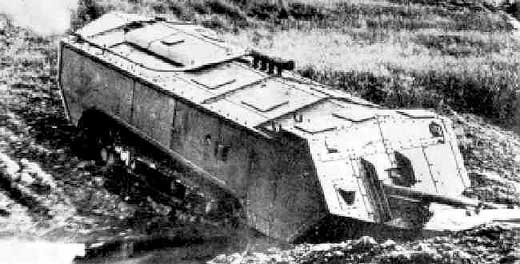 A St-Chamond tank taking a chance in the mud.. Stuck tanks were sitting targets for the enemy especially if your tank didn't have a movable turret This design would prove faulty in combat. The tank would often get stuck and the driver would often burn out the electric motors attempting to dislodge it. The prototype had a flat roof and armor down over the tracks, but this limited access for maintenance and became clogged with mud, so the side armor was cutaway to expose the tracks. |
Specifications Weight: 41 tons Crew: 7 Armor: 11.5mm (early) 17mm (late) Performance: max road speed 5.3mph Armament: 105mm:*, 2 x 8mm MG Engine:** Renault: V12, 240hp Length: 27.34' Height: 9.33' Width: 6.5' *75 mm gun for first 165 was Saint Chamond TR commercial gun, for last 235 was Model 1897(L/36) up to four Hotchkiss 8mm MGs. **one 90hp Panhard four cylinder petrol engine powering a Crochat-Collardeau electric transmission. This combination would prove faulty in combat. The tank would often get stuck and the driver would often burn out the electric motors attempting to dislodge it.
|
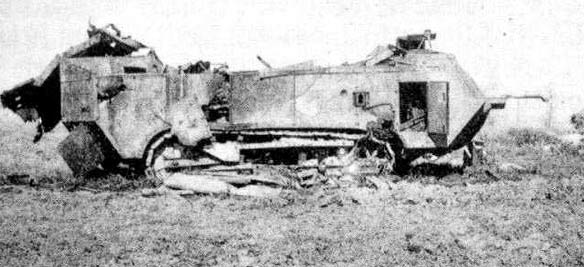 In WWI, tank duty was tantamount to a death sentence. If the heat and carbon monoxide didn't kill you, German artillery probably would. Note how intensely the roof has been blown away |
The St Chamond was first used in action on May 5 1917, in support of an infantry attack at Mole de Afflux. The major flaw in the construction - the small drive train and the big front overhang - at once revealed itself.. of the 16 St Chamond tanks that participated in the assault, and unbelievable 15 got firmly stuck when they attempted to cross the German trenches. In the next big tank attack, both Schneider CA 1s and St Chamond's participated, but the result was again a flop !! Only the CA 1s managed to pass the German trenches! |
Deutsches Panzermuseum - German Tank Museum WWI Tanks in the Collection |






